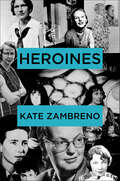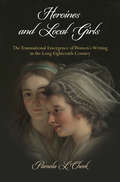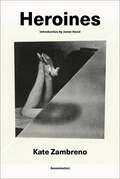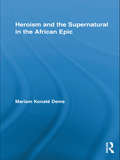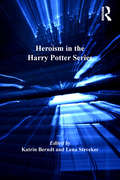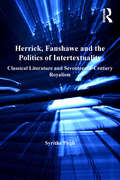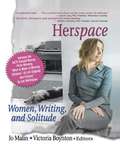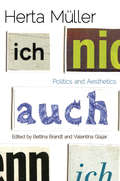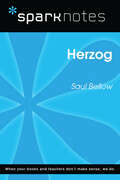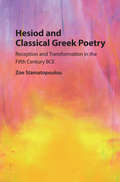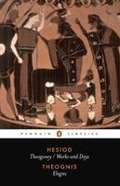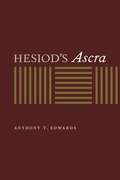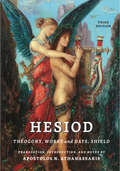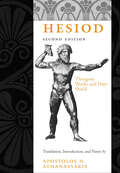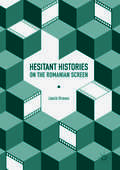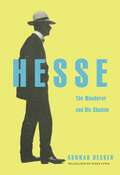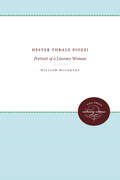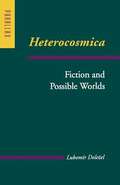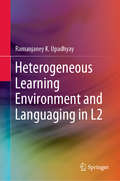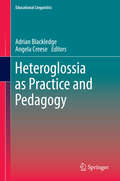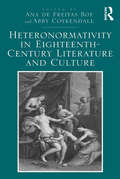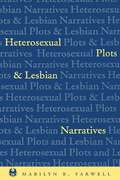- Table View
- List View
Heroines
by Kate ZambrenoA manifesto for "toxic girls" that reclaims the wives and mistresses of modernism for literature and feminism.I am beginning to realize that taking the self out of our essays is a form of repression. Taking the self out feels like obeying a gag order―pretending an objectivity where there is nothing objective about the experience of confronting and engaging with and swooning over literature."― from HeroinesOn the last day of December, 2009 Kate Zambreno began a blog called Frances Farmer Is My Sister, arising from her obsession with the female modernists and her recent transplantation to Akron, Ohio, where her husband held a university job. Widely reposted, Zambreno's blog became an outlet for her highly informed and passionate rants about the fates of the modernist "wives and mistresses." In her blog entries, Zambreno reclaimed the traditionally pathologized biographies of Vivienne Eliot, Jane Bowles, Jean Rhys, and Zelda Fitzgerald: writers and artists themselves who served as male writers' muses only to end their lives silenced, erased, and institutionalized. Over the course of two years, Frances Farmer Is My Sister helped create a community where today's "toxic girls" could devise a new feminist discourse, writing in the margins and developing an alternative canon.In Heroines, Zambreno extends the polemic begun on her blog into a dazzling, original work of literary scholarship. Combing theories that have dictated what literature should be and who is allowed to write it―from T. S. Eliot's New Criticism to the writings of such mid-century intellectuals as Elizabeth Hardwick and Mary McCarthy to the occasional "girl-on-girl crime" of the Second Wave of feminism―she traces the genesis of a cultural template that consistently exiles female experience to the realm of the "minor," and diagnoses women for transgressing social bounds. "ANXIETY: When she experiences it, it's pathological," writes Zambreno. "When he does, it's existential." By advancing the Girl-As-Philosopher, Zambreno reinvents feminism for her generation while providing a model for a newly subjectivized criticism.
Heroines
by Kate Zambreno'I am beginning to realize that taking the self out of our essays is a form of repression. Taking the self out feels like obeying a gag order - pretending an objectivity where there is nothing objective about the experience of confronting and engaging with and swooning over literature'On the last day of December 2009 Kate Zambreno, then an unpublished writer, began a blog arising from her obsession with literary modernism. Widely shared on social media, Zambreno's blog became an outlet for her highly informed and passionate rants and melancholy portraits of the fates of the modernist 'wives and mistresses,' reclaiming the traditionally pathologized biographies of Vivienne Eliot, Jane Bowles, Jean Rhys, and Zelda Fitzgerald: writers and artists themselves who served as male writers' muses only to end their lives silenced, erased, and institutionalized. Over the course of two years, her blog helped create a community of writers and devised a new feminist discourse of writing in the margins and developing an alternative canon.In Heroines, Zambreno extends the polemic she began online into a dazzling, original work of literary scholarship. Combing theories that have dictated what literature should be and who is allowed to write it - she traces the genesis of a cultural template that consistently exiles feminine experience to the realm of the 'minor,' and diagnoses women for transgressing social bounds. 'ANXIETY: When she experiences it, it's pathological,' writes Zambreno. 'When he does, it's existential.'With Heroines, Zambreno provided a model for a newly subjectivized criticism, prefiguring many group biographies and forms of autotheory and hybrid memoirs that were to come in the years to follow.
Heroines and Local Girls: The Transnational Emergence of Women's Writing in the Long Eighteenth Century (Haney Foundation Series)
by Pamela L. CheekOver the course of the long eighteenth century, a network of some fifty women writers, working in French, English, Dutch, and German, staked out a lasting position in the European literary field. These writers were multilingual and lived for many years outside of their countries of origin, translated and borrowed from each others' works, attended literary circles and salons, and fashioned a transnational women's literature characterized by highly recognizable codes. Drawing on a literary geography of national types, women writers across Western Europe read, translated, wrote, and rewrote stories about exceptional young women, literary heroines who transcend the gendered destiny of their distinctive cultural and national contexts. These transcultural heroines struggle against the cultural constraints determining the sexualized fates of local girls.In Heroines and Local Girls, Pamela L. Cheek explores the rise of women's writing as a distinct, transnational category in Britain and Europe between 1650 and 1810. Starting with an account of a remarkable tea party that brought together Frances Burney, Sophie von La Roche, and Marie Elisabeth de La Fite in conversation about Stéphanie de Genlis, she excavates a complex community of European and British women authors. In chapters that incorporate history, network theory, and feminist literary history, she examines the century-and-a-half literary lineage connecting Madame de Maintenon to Mary Wollstonecraft, including Charlotte Lennox and Françoise de Graffigny and their radical responses to sexual violence. Neither simply a reaction to, nor collusion with, patriarchal and national literary forms but, rather, both, women's writing offered an invitation to group membership through a literary project of self-transformation. In so doing, argues Cheek, women's writing was the first modern literary category to capitalize transnationally on the virtue of identity, anticipating the global literary marketplace's segmentation of affinity-based reading publics, and continuing to define women's writing to this day.
Heroines, new edition (Semiotext(e) / Active Agents)
by Kate ZambrenoA manifesto reclaiming the wives and mistresses of literary modernism that inspired a generation of writers and scholars, reissued after more than a decade.I am beginning to realize that taking the self out of our essays is a form of repression. Taking the self out feels like obeying a gag order—pretending an objectivity where there is nothing objective about the experience of confronting and engaging with and swooning over literature.On the last day of December 2009, Kate Zambreno, then an unpublished writer, began a blog called "Frances Farmer Is My Sister," arising from her obsession with literary modernism and her recent transplantation to Akron, Ohio, where her partner held a university job. Widely reposted, Zambreno's blog became an outlet for her highly informed and passionate rants and melancholy portraits of the fates of the modernist &“wives and mistresses," reclaiming the traditionally pathologized biographies of Vivienne Eliot, Jane Bowles, Jean Rhys, and Zelda Fitzgerald: writers and artists themselves who served as male writers' muses only to end their lives silenced, erased, and institutionalized. Over the course of two years, Frances Farmer Is My Sister helped create a community of writers and devised a new feminist discourse of writing in the margins and developing an alternative canon. In Heroines, Zambreno extends the polemic begun on her blog into a dazzling, original work of literary scholarship. Combing theories that have dictated what literature should be and who is allowed to write it—she traces the genesis of a cultural template that consistently exiles feminine experience to the realm of the &“minor,&” and diagnoses women for transgressing social bounds. &“ANXIETY: When she experiences it, it's pathological,&” writes Zambreno. &“When he does, it's existential.&” With Heroines, Zambreno provided a model for a newly subjectivized criticism, prefiguring many group biographies and forms of autotheory and hybrid memoirs that were to come in the years to follow. A book that has become its own canon, Heroines was named one of the "50 Books that define the past 5 Years in Literature" by Flavorwire, an "Essential Feminist Manifesto" by Dazed, and one of the "50 Greatest Books by Women" in Buzzfeed.
Heroism and the Supernatural in the African Epic (African Studies)
by Mariam Konaté DemeThere exists a strong tendency within Western literary criticism to either deny the existence of epics in Africa or to see African literatures as exotic copies of European originals. In both cases, Western criticism has largely failed to acknowledge the distinctiveness of African literary aesthetics. This book revises traditional literary canons in examining the social, cultural and emotional specificity of African epics. Mariam Konate Deme highlights the distinguishing features that characterize the African epic, emphasizing the significance of the fantastic and its use as an essential element in the dramatic structure of African epics. As Deme notes, the fantastic can be fully appreciated only against the cosmological background of the societies that produce those heroic tales. This book not only contributes to the scholarship on African oral literature, but also adds reshapes our understanding of heroic literature in general.
Heroism in the Harry Potter Series (Studies in Childhood, 1700 to the Present)
by Katrin Berndt Lena StevekerTaking up the various conceptions of heroism that are conjured in the Harry Potter series, this collection examines the ways fictional heroism in the twenty-first century challenges the idealized forms of a somewhat simplistic masculinity associated with genres like the epic, romance and classic adventure story. The collection's three sections address broad issues related to genre, Harry Potter's development as the central heroic character and the question of who qualifies as a hero in the Harry Potter series. Among the topics are Harry Potter as both epic and postmodern hero, the series as a modern-day example of psychomachia, the series' indebtedness to the Gothic tradition, Harry's development in the first six film adaptations, Harry Potter and the idea of the English gentleman, Hermione Granger's explicitly female version of heroism, adult role models in Harry Potter, and the complex depictions of heroism exhibited by the series' minor characters. Together, the essays suggest that the Harry Potter novels rely on established generic, moral and popular codes to develop new and genuine ways of expressing what a globalized world has applauded as ethically exemplary models of heroism based on responsibility, courage, humility and kindness.
Heroism in the New Black Poetry: Introductions and Interviews
by D. H. MelhemThe six poets studied here--Amiri Baraka, Gwendolyn Brooks, Jayne Cortez, Haki R. Madhubuti, Dudley Randall, and Sonia Sanchez--offer frank analyses of the tensions and preoccupations that have shaped their attitudes toward art, race, community, sexuality, politics, religion.
Herrick, Fanshawe and the Politics of Intertextuality: Classical Literature and Seventeenth-Century Royalism
by Syrithe PughRoyalist polemic and a sophisticated use of classical allusion are at the heart of the two 1648 volumes which are the focus of this study, yet there are striking differences in their politics and in the ways they represent their relation to poetry of the past. Pugh's study of these brilliant but neglected poets brings nuance to our understanding of literary royalism, and considers the interconnections between politics and poetics. Through a series of detailed close readings revealing the complex and nuanced significance of classical allusion in individual poems, together with an historically informed consideration of the polemical force of both publishing acts, Pugh aligns the two poets with competing factions within the royalist camp. These political differences, she argues, are reflected not only in the idea of monarchy explicitly articulated in their poetry, but also in the distinctive theories of intertextuality foregrounded in each volume, Herrick's absolutism going hand-in -hand with his peculiarly transcendental image of poetic imitation as an immortal symposium, Fanshawe's constitutionalism with a distinctly humanist approach. Offering a new argument for the unity of Herrick's vast collection Hesperides, and making a case for the rehabilitation of Richard Fanshawe, this engaging book will also be of wider interest to anyone concerned with politics in seventeenth-century literature or with classical reception.
Herspace: Women, Writing, and Solitude
by J Dianne Garner Victoria Boynton Jo MalinThis collection delves deeply into the power of solitude in a richly detailed exploration of the lives of women writers! The essays in this fascinating volume combine literary theory, autobiography, performance, and criticism, while opening minds and expanding concepts of women's roles both in the home and within academia along the way. Herspace: Women, Writing, and Solitude begins with a discussion of the importance of solitude to the works of a variety of writers, including Margaret Atwood, May Sarton, Virginia Woolf, Marguerite Duras, and Zora Neale Hurston, and then moves on to an examination of the actual solitary spaces of women writers. The book concludes with the stories of modern women asserting their right to a space of their own. These essays, full of pain and new growth, lessons learned and battles fought, resound with the honesty and courage the authors have found in the process of truly making their own homes. Herspace examines: the stereotyped spinster solitude as a process and a journey women's prison literature cars, empty nests, kitchen counters, and other found spaces for writing the meaning of a home of one's own creating beauty in solitary settings Contributors to Herspace have made a conscious effort to integrate the personal with the academic, and the result is a volume of surprising intimacy, a window into the world of women writers past and present actively engaging solitude. From finding and defining the muse to the identity issues of home ownership, Herspace, which includes Jan Wellington's essay "What to Make of Missing Children (A Life Slipping into Fiction)," (winner of the 2003 NCTE Donald Murray Prize for "the best creative essay about teaching and/or writing published during the preceding year") provides you with the perspectives of women who are living these issues. As the editors write: "The solitary space itself enables the writing process, protects it. And women, more than men, need this enabling protection. Women need to claim their own space, to bargain and plan and keep out of sight that solitary space in which to commune with their thoughts and feelings, to experience their creative process intimately." Herspace explores these women's experiences, revealing the unique creativity that comes from solitude.
Herta Müller: Politics and Aesthetics
by Bettina BrandtTwo languages—German and Romanian—inform the novels, essays, and collage poetry of Nobel laureate Herta Müller. Describing her writing as &“autofictional,&” Müller depicts the effects of violence, cruelty, and terror on her characters based on her own experiences in Communist Romania under the repressive Nicolae Ceauşescu regime.Herta Müller: Politics and Aesthetics explores Müller&’s writings from different literary, cultural, and historical perspectives. Part 1 features Müller&’s Nobel lecture, five new collage poems, and an interview with Ernest Wichner, a German-Romanian author who has traveled with her and sheds light on her writing. Parts 2 and 3, featuring essays by scholars from across Europe and the United States, address the political and poetical aspects of Müller&’s texts. Contributors discuss life under the Romanian Communist dictatorship while also stressing key elements of Müller&’s poetics, which promises both self-conscious formal experimentation and political intervention.One of the first books in English to thoroughly examine Müller&’s writing, this volume addresses audiences with an interest in dissident, exile, migration, experimental, and transnational literature.
Herzog (SparkNotes Literature Guide Series)
by SparkNotesHerzog (SparkNotes Literature Guide) by Saul Bellow Making the reading experience fun! Created by Harvard students for students everywhere, SparkNotes is a new breed of study guide: smarter, better, faster.Geared to what today's students need to know, SparkNotes provides:chapter-by-chapter analysis explanations of key themes, motifs, and symbols a review quiz and essay topics Lively and accessible, these guides are perfect for late-night studying and writing papers.
Hesiod and Classical Greek Poetry: Reception and Transformation in the Fifth Century BCE
by Zoe StamatopoulouHesiod was regarded by the Greeks as a foundational figure of their culture, alongside Homer. This book examines the rich and varied engagement of fifth-century lyric and drama with the poetic corpus attributed to Hesiod as well as with the poetic figure of Hesiod. The first half of the book is dedicated to Hesiodic reception in Pindaric and Bacchylidean poetry, with a particular focus on poetics, genealogies and mythological narratives, and didactic voices. The second half examines how Hesiodic narratives are approached and appropriated in tragedy and satyr drama, especially in the Prometheus plays and in Euripides' Ion. It also explores the multifaceted engagement of Old Comedy with the poetry and authority associated with Hesiod. Through close readings of numerous case studies, the book surveys the complex landscape of Hesiodic reception in the fifth century BCE, focusing primarily on lyric and dramatic responses to the Hesiodic tradition.
Hesiod and Theognis: Theogony, Works and Days, and Elegies
by Hesiod Theognis Dorothea WenderTogether these two poets-Hesiod, the epic poet, and Theognis, the elegist-offer a superb introduction to the life and thought of ancient Greece.
Hesiod's Ascra
by Anthony T. EdwardsAnthony T. Edwards extracts from Hesiod's poem "Works and Days" a picture of the social structure of Ascra, the hamlet in northern Greece where Hesiod lived, most likely during the seventh century B.C.E.
Hesiod: Theogony, Works and Days, Shield
by Apostolos N. AthanassakisThis best-selling translation of Hesiod's the Theogony, the Works and Days, and the Shield has been updated into the most indispensable edition yet for students of Greek mythology and literature.Next to the works of Homer, Hesiod's poems are foundational texts for students of the classics. His two major surviving works, the Theogony and the Works and Days, address the divine and the mundane, respectively. The Theogony traces the origins of the Greek gods and recounts the events surrounding the crowning of Zeus as their king, while the Works and Days is a manual of moral instruction in verse addressed to farmers and peasants. Though modern scholars dispute the authorship of the Shield, ancient texts treat this final poem about the shield of Herakles as unquestionably Hesiodic.Introducing his celebrated translations of Hesiod, Apostolos N. Athanassakis positions the philosopher-poet as heir to a long tradition of Hellenic poetry. Hesiod's poems demonstrate the author's passionate interest in the governance of human society through justice and a tangible work ethic. As a physicist and a materialist, Hesiod avoided such subjects as honor and the afterlife. His works contain the oldest fundamentals on law and Greek economy, making Hesiod the first great thinker of Western civilization. Athanassakis's contextual notes offer both comparison to Biblical and Norse mythologies as well as anthropological connections to modern Greece.The third edition of this classic undergraduate text includes a thoroughly updated bibliography reflecting the last two decades of scholarship. The introductions and notes have been enriched, clarifying contextual history and the meaning of Hesiod's own language and themes, and notes have been newly added to the Shield. Athanassakis has lightly improved his translation throughout the text, expertly balancing the natural flow of the verse while adhering closely to the literal Greek.
Hesiod: Theogony, Works and Days, Shield
by HesiodHesiod belongs to the transitional period in Greek civilization between the oral tradition and the introduction of a written alphabet. His two major surviving works, the Theogony and the Works and Days, address the divine and the mundane, respectively. The Theogony traces the origins of the Greek gods and recounts the events surrounding the crowning of Zeus as their king. A manual of moral instruction in verse, the Works and Days was addressed to farmers and peasants.Introducing his celebrated translations of these two poems and of the Shield, a very ancient poem of disputed authorship, Apostolos Athanassakis positions Hesiod simultaneously as a philosopher-poet, a bard with deep roots in the culture of his native Boeotia, and the heir to a long tradition of Hellenic poetry. For this eagerly anticipated revised edition, Athanassakis has provided an expanded introduction on Hesiod and his work, subtly amended his faithful translations, significantly augmented the notes and index, and updated the bibliography. Already a classic, Hesiod: Theogony, Works and Days, Shield is now more valuable than ever for students of Greek mythology and literature.
Hesiodic voices
by Richard HunterThis book selects central texts illustrating the literary reception of Hesiod's Works and Days in antiquity and considers how these moments were crucial in fashioning the idea of 'didactic literature'. A central chapter considers the development of ancient ideas about didactic poetry, relying not so much on explicit critical theory as on how Hesiod was read and used from the earliest period of reception onwards. Other chapters consider Hesiodic reception in the archaic poetry of Alcaeus and Simonides, in the classical prose of Plato, Xenophon and Isocrates, in the Aesopic tradition, and in the imperial prose of Dio Chrysostom and Lucian; there is also a groundbreaking study of Plutarch's extensive commentary on the Works and Days and an account of ancient ideas of Hesiod's linguistic style. This is a major and innovative contribution to the study of Hesiod's remarkable poem and to the Greek literary engagement with the past.
Hesitant Histories on the Romanian Screen
by László StrauszThis book argues that hesitation as an artistic and spectatorial strategy connects various screen media texts produced in post-war Romania. The chapters draw a historical connection between films made during the state socialist decades, televised broadcasts of the 1989 Romanian revolution, and films of the new Romanian cinema. The book explores how the critical attitude of new Romanian cinema demonstrates a refusal to accept limiting, binary discourses rooted in Cold War narratives. Strausz argues that hesitation becomes an attempt to overcome restrictive populist narratives of the past and present day. By employing a performative and mobile position, audiences are encouraged to consider conflicting approaches to history and social transformation.
Hesse: The Wanderer and His Shadow
by Gunnar DeckerAgainst Nazi dictatorship,the disillusionment of Weimar, and Christian austerity, Hermann Hesse’s stories inspired a nonconformist yearning for universal values to supplant fanaticism in all its guises. He reenters our world through Gunnar Decker’s biography—a champion of spiritual searching in the face of mass culture and the disenchanted life.
Hester Thrale Piozzi: Portrait of a Literary Woman
by William McCarthyMuch has been written about Thrale, friend and hostess of Samuel Johnson, but this is the first study to focus on Piozzi as the writer. In his narrative of her life, McCarthy draws on a large body of published and unpublished sources to map Piozzi's literary development, define her literary identity, and evaluate her achievement. In addition to reexamining her best-known works, he present the first serious treatment of her poetry, political works, and historical writings.Originally published in 1985.A UNC Press Enduring Edition -- UNC Press Enduring Editions use the latest in digital technology to make available again books from our distinguished backlist that were previously out of print. These editions are published unaltered from the original, and are presented in affordable paperback formats, bringing readers both historical and cultural value.
Heterocosmica: Fiction And Possible Worlds (Parallax: Re-visions Of Culture And Society)
by Lubomír Dolezel"The universe of possible worlds is constantly expanding and diversifying thanks to the incessant world-constructing activity of human minds and hands. Literary fiction is probably the most active experimental laboratory of the world-constructing enterprise."—from the author's Preface <P><P> The standard contrast between fiction and reality, notes Lubomír Dolezel, obscures an array of problems that have beset philosophers and literary critics for centuries. Commentators usually admit that fiction conveys some kind of truth—the truth of the story of Faust, for instance. They acknowledge that fiction usually bears some kind of relation to reality—for example, the London of Dickens. But both the status of the truth and the nature of the relationship have baffled, frustrated, or repelled a long line of thinkers. <P><P> In Heterocosmica, Lubomír Dolezel offers nothing less than a complete theory of literary fiction based on the idea of possible worlds. Beginning with a discussion of the extant semantics and pragmatics of fictionality—by Leibniz, Russell, Frege, Searle, Auerbach, and others—he relates them to literature, literary theory, and narratology. He also investigates theories of action, intention, and literary communication to develop a system of concepts that allows him to offer perceptive reinterpretations of a host of classical, modern, and postmodern fictional narratives—from Defoe through Dickens, Dostoevsky, Huysmans, Bely, and Kafka to Hemingway, Kundera, Rhys, Plenzdorf, and Coetzee. By careful attention to philosophical inquiry into possible worlds, especially Saul Kripke's and Jaakko Hintikka's, and through long familiarity with literary theory, Dolezel brings us an unprecedented examination of the notion of fictional worlds.
Heterogeneous Learning Environment and Languaging in L2 (Springerbriefs In Education Ser.)
by Ramanjaney K. UpadhyayThis book explores heterogeneity in the Indian academic setting. Presenting a study on the performance of Bachelor of Engineering students from various parts of the county, it analyzes the subjects’ language skills on the basis of selected sociolinguistic variables and examines the possible role/impact of using multiple languages in the communicative setting described. In turn, the book investigates the differences between the way language is viewed in the Orient and in the Western world, and how, despite their differences, these views lead to similar language teaching methods in both worlds. It also highlights the limitations of current theories and frameworks in terms of accommodating modern methods of assessing language skills. Addressing socio-pragmatic issues in terms of English proficiency and language assessment, it is the first book to offer such a focused and detailed discussion of these varied but related issues, making it a valuable resource for all scholars and researchers working in the areas of socio-pragmatics, language assessment, and intercultural communication.
Heteroglossia as Practice and Pedagogy
by Angela Creese Adrian BlackledgeThis volume presents evidence about how we understand communication in changing times, and proposes that such understandings may contribute to the development of pedagogy for teaching and learning. It expands current debates on multilingualism, asking which signs are in use and in action, and what are their social, political, and historical implications. The volume's starting-point is Bakhtin's 'heteroglossia', a key concept in understanding the tensions, conflicts, and multiple voices within, among, and between those signs. The chapters provide illuminating accounts of language practices as they bring into play, both in practice and in pedagogy, voices which index students' localities, social histories, circumstances, and identities. The book documents the performance of linguistic repertoires in an era of profound social change caused by the shifting nature of nation-states, increased movement of people across territories, and growing digital communication. "Our thinking on language and multilingualism is expanding rapidly. Up until recently we have tended to regard languages as bounded entities, and multilingualism has been understood as knowing more than one language. Working with the concept of heteroglossia, researchers are developing alternative perspectives that treat languages as sets of resources for expressing meaning that can be drawn on by speakers in communicatively productive ways in different contexts. These perspectives raise fundamental questions about the myriad of ways of knowing and using language(s). This collection brings together the contributions of many of the key researchers in the field. It will provide an authoritative reference point for contemporary interpretations of 'heteroglossia' and valuable accounts of how 'translanguaging' can be explored and exploited in the fields of education and cultural studies. " Professor Constant Leung, King's College London, UK. "From rap and hip hop to taxi cabs, and from classrooms to interactive online learning environments, each of the chapters in this volume written by well-known and up-and-coming scholars provide fascinating accounts drawing on a wide diversity of rich descriptive data collected in heteroglossic contexts around the globe. Creese and Blackledge have brought together a compelling collection that builds upon and expands Bakhtin's construct of heteroglossia. These scholars help to move the field away from the view of languages as separate bounded system by providing detailed examples and expert analyses of the ways bilinguals and multilinguals draw upon their linguistic repertoires for effective and meaningful communication. " Wayne E. Wright, University of Texas at San Antonio, USA.
Heteronormativity in Eighteenth-Century Literature and Culture
by Ana de Boe Abby CoykendallThe resurgence of marriage as a transnational institution, same-sex or otherwise, draws upon as much as it departs from enlightenment ideologies of sex, gender, and sexuality which this collection aims to investigate, interrogate, and conceptualize anew. Coming to terms with heteronormativity is imperative for appreciating the literature and culture of the eighteenth century writ large, as well as the myriad imaginaries of sex and sexuality that the period bequeaths to the present. This collection foregrounds British, European, and, to a lesser extent, transatlantic heteronormativities in order to pose vital if vexing questions about the degree of continuity subsisting between heteronormativities of the past and present, questions compounded by the aura of transhistoricity lying at the heart of heteronormativity as an ideology. Contributors attend to the fissures and failures of heteronormativity even as they stress the resilience of its hegemony: reconfiguring our sense of how gender and sexuality came to be mapped onto space; how public and private spheres were carved up, or gendered and sexual bodies socially sanctioned; and finally how literary traditions, scholarly criticisms, and pedagogical practices have served to buttress or contest the legacy of heteronormativity.
Heterosexual Plots and Lesbian Narratives (The Cutting Edge: Lesbian Life and Literature Series)
by Marilyn FarwellWhat is lesbian literature? Must it contain overtly lesbian characters, and portray them in a positive light? Must the author be overtly (or covertly) lesbian? Does there have to be a lesbian theme and must it be politically acceptable? Marilyn Farwell here examines the work of such writers as Adrienne Rich, Marion Zimmer Bradley, Jeanette Winterson, Gloria Naylor, and Marilyn Hacker to address these questions. Dividing their writings into two genres--the romantic story and the heroic, or quest, story, Farwell addresses some of the most problematic issues at the intersection of literature, sex, gender, and postmodernism. Illustrating how the generational conflict between the lesbian- feminists of twenty years ago and the queer theorists of today stokes the critical fires of contemporary lesbian and literary theory, Heterosexual Plots and Lesbian Narratives concludes by arguing for a broad and generous definition of lesbian writing.
